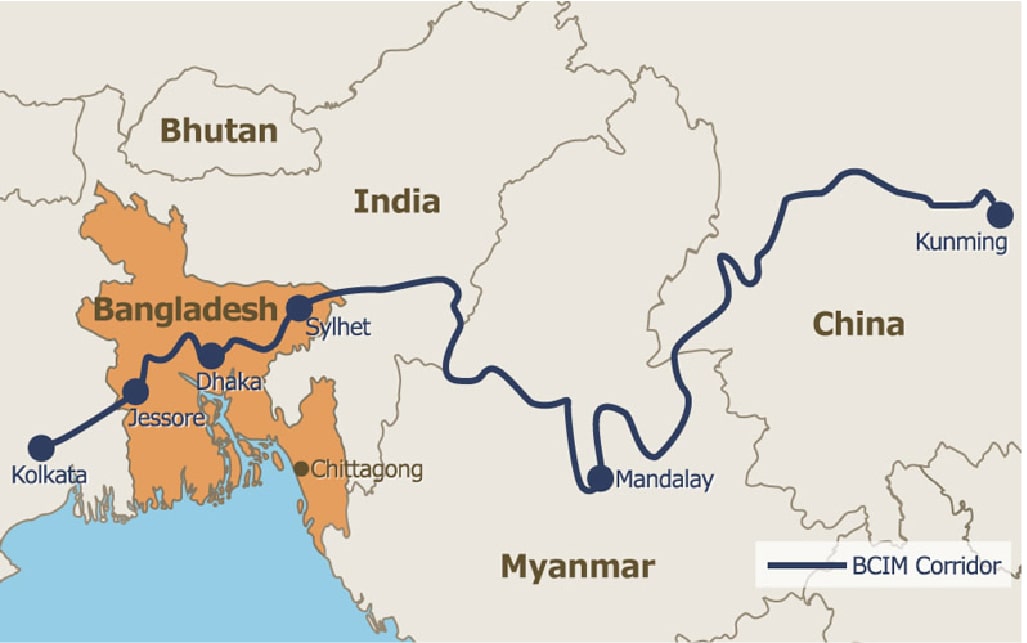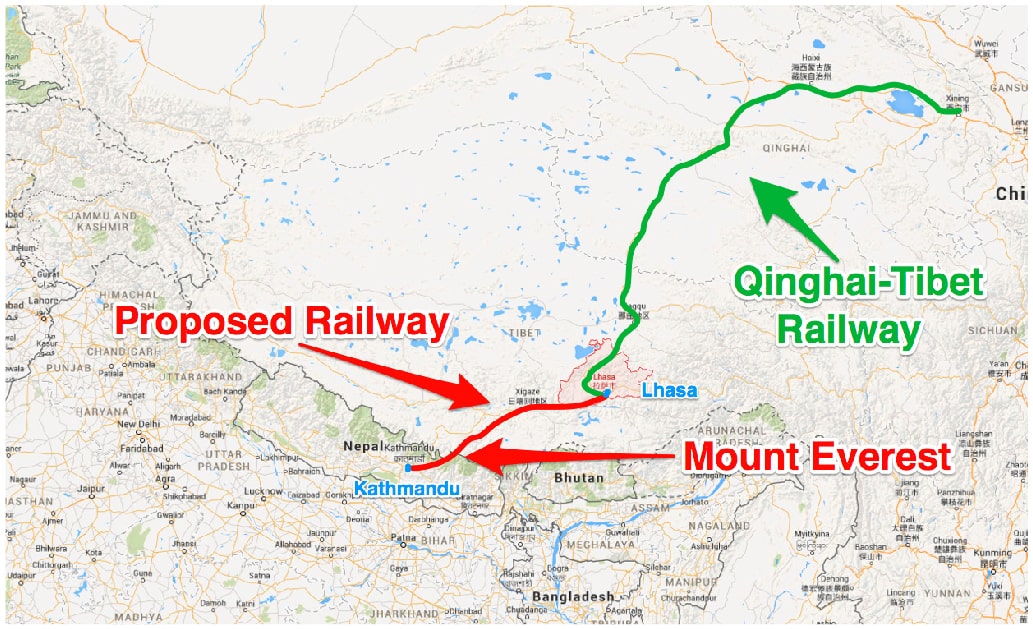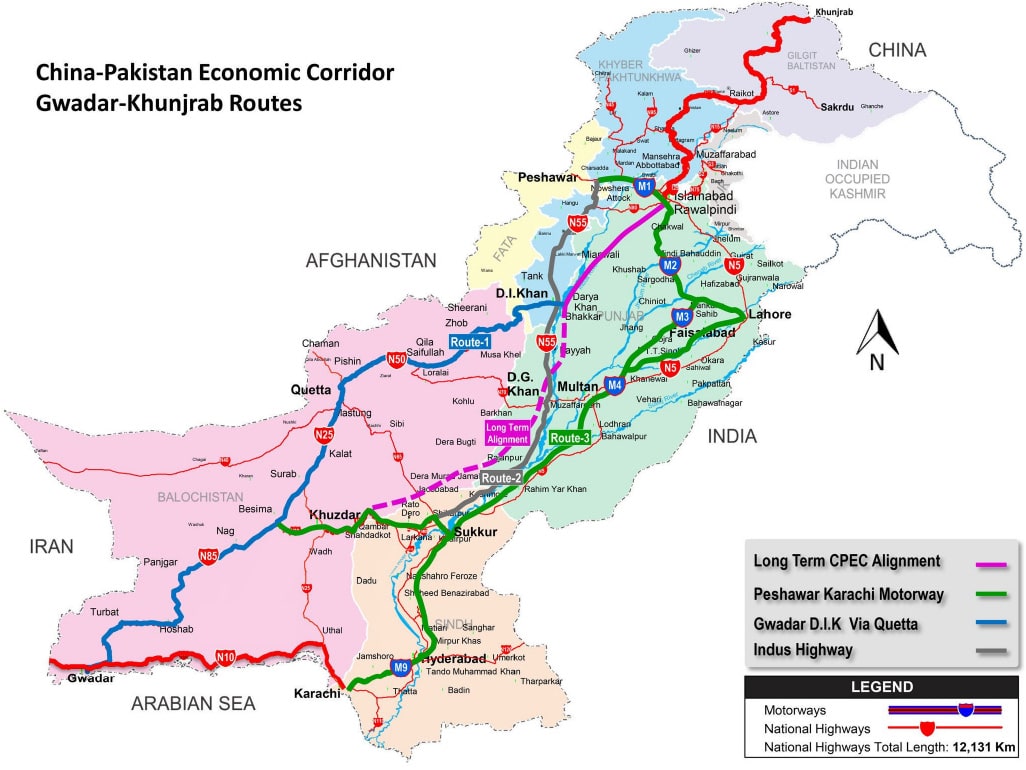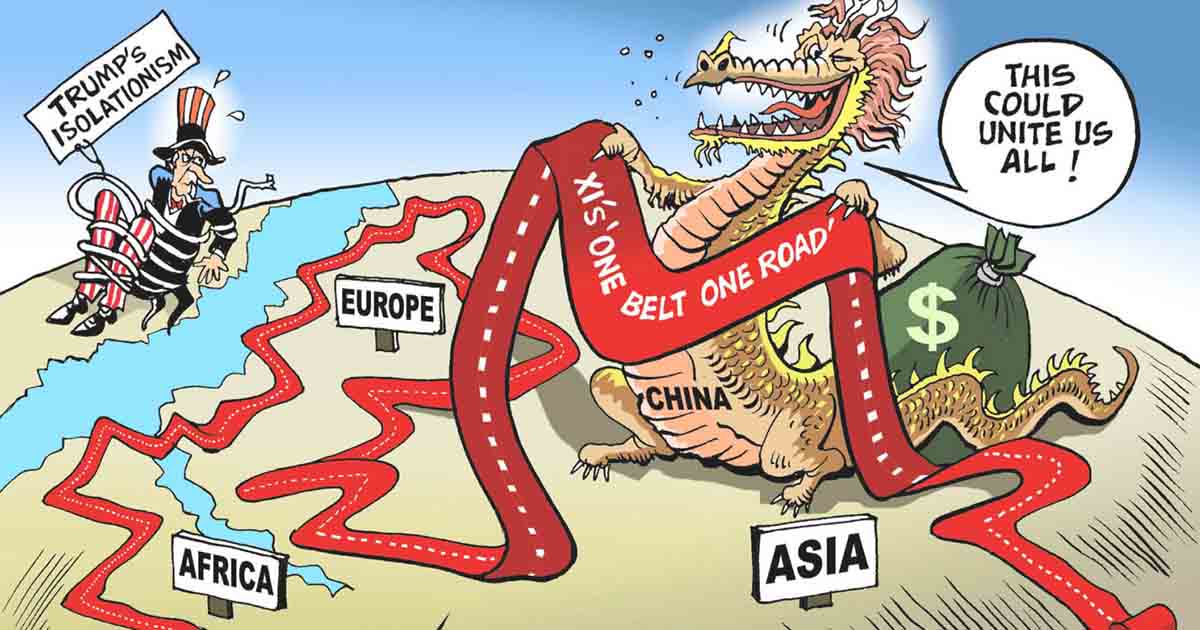The Strategic Vision Behind the Silk Road
The early part of the 21st-century is witnessing an astronomically rapid rise of China as a global superpower, aided and abetted by a combination of factors that most importantly include the United State’s own strategic missteps in the Middle East and the benign win-win comprehensive partnerships that Beijing has clinched all across the “Global South”.
By 2013, the People’s Republic realized that it would have to affect permanent institutional and economic change, in the region around it, if it was to stand any chance of retaining its newfound position in the face of growing American opposition to its worldwide role, which is why President Xi announced his country’s One Belt One Road (OBOR) global vision of New Silk Road connectivity.
Read more: Why China added The Belt & Road Initiative to its Constitution?
This ambitious initiative aims to expand China’s mainland and maritime trade routes to the furthest corners of the world, solidify them in terms of tangible connective infrastructure projects that unleash its partners’ full economic potential, and ultimately use this new network as the basis for constructing multipolar institutions to complement, compete with, and then finally replace their existing unipolar counterparts.
The prevailing concept is that China can progressively transition the architecture of “International Relations” from the declining “Unipolar World Order” to the emerging “Multipolar World Order” via the peaceful means of infrastructural-development initiatives that collectively redirect global strategic gravity from the West to the East. To that end, China naturally envisions the neighboring South Asian region as a launching pad for many of its OBOR projects.
Read more: CPEC will not stir up Indo-Pak Trouble, says China
The Silk Road Comes to South Asia
Every South Asian state with the exception of Bhutan is part of one or the other Silk Road plan, though, out of all of them, India has the distinction of being the only country that is against this multipolar cooperative effort.
In fact, India was the only country to decline attending the OBOR Summit in May 2017, supposedly due to its opposition to the China-Pakistan Economic Corridor (CPEC) transiting through the Pakistani province of Gilgit-Baltistan, that New Delhi claims as its own, as per the country’s maximalist approach to the Kashmir conflict.
This hostile state of affairs is very unbecoming for a nominal BRICS “ally”, that India is supposed to be. This obviously caught the US’ attention because Washington plans to exploit the situation in order to make New Delhi its “Lead from Behind” proxy partner for disrupting the Silk Road’s progress in South Asia.

CPEC: China-Pakistan Economic Corridor
Just like the US “flipped” China against the USSR in the old Cold War by taking advantage of preexisting and longstanding issues between the two, it is now doing the same by turning India against China in the New Cold War over competitive connectivity projects.
This will be explored more in depth later, but it’s important to first explain China’s BRI plans for South Asia, whether already implemented or projected, as this will enable the reader to better understand how India could be used to offset them with American support.
Beginning with the most important one, CPEC is the flagship of the entire BRI vision and will crucially allow China to connect with the Afro-Indian Ocean upon its completion, thereby detouring around the bottlenecked Strait of Malacca and liberating the People’s Republic from the strategic blackmail that the US Navy is presently exerting on it.
Read more: Why China wants to ‘speed up’ CPEC’s construction?
The Himalayan Silk Road
Moving eastward and keeping to the mainland for the moment, the next most relevant project could colloquially be called the Himalayan Silk Road, which reflects China’s desire to expand its high-speed railway system from the Tibet Autonomous Region to landlocked Nepal, with the potential opportunity to possibly even one day stretch it to India’s West Bengal port of Kolkata or Bangladesh.
Given India’s opposition to BRI, this grand vision probably won’t be possible, but in any case, the Himalayan Silk Road could facilitate the transhipment of Chinese products from Nepal to the Indian marketplace by exploiting the porous borders and free trade agreement between the two historically aligned states.
The driving idea behind this strategy isn’t to “subvert” India but to strengthen its complex economic interdependence with China so as to make any American-encouraged provocations against Beijing’s interests equally counterproductive to New Delhi’s own vested interests.

CMEC: China Myanmar Economic Corridor
The next mainland Silk Road in South Asia is the Bangladesh- China-India-Myanmar Economic Corridor (BCIM), but it’s impossible to ever actualize it to the extent that it was envisioned because of New Delhi’s primal opposition to BRI.
This means that the most pertinent development that might arise from this plan is the China-Myanmar Economic Corridor (CMEC), which could run parallel to the two oil and gas pipelines from the Bay of Bengal port of Kyaukphyu to the Yunnan capital of Kunming in serving as a complement to CPEC via the Afro-Indian Ocean access that it would provide to Beijing.
Having completed a review of BRI’s mainland South Asian projects, it’s now time to touch upon its maritime dimensions; such as the inroads that China is making in Bangladesh, particularly its port of Chittagong.
Read more: CPEC’s vulnerabilities: Can Pakistan carve a way out?
Bangladesh, Sri Lanka, and the Maldives
The lands of what was formerly East Pakistan sit at the northern apex of the Bay of Bengal, from which it derives its geostrategic importance in facilitating multimodal economic integration in the region.
As for nearby Sri Lanka and the Maldives, these two island nations sit along the Sea Lines of Communication (SLOC) that connect East Asia with the African, Middle Eastern, and European marketplaces, though their Silk Road importance will relatively lessen with time once CPEC begins rerouting these trans-oceanic trade networks to Gwadar and thenceforth to the Chinese mainland.
Nevertheless,Sri Lanka and the Maldives will always remain important because China’s maritime trade across the Afro-Indian Ocean will never completely go away, and it will still take CPEC a while to become fully operational. That’s why these two states still occupy a significant place in China’s Silk Road geopolitics and will continue to do so in the future.
Read More: Book Review: China’s Maritime Silk Road Initiative and South Asia
Hybrid War Threats
China’s Silk Roads are inherently vulnerable to Hybrid Wars which in this context may emerge as the external provocation of “identity conflicts” in diverse states in order to disrupt, control, or influence the transnational connective infrastructure projects through a variety of political outcomes.
It is sufficient to point out that all of the South Asian states, that host China’s BRI projects, satisfy the criteria of being diverse in the ethnic, religious, historical, socio-economic, geographic & administrative or political sense, thus making them vulnerable to Hybrid Wars.
The theoretical paradigm is a bit more complex than that, but it’s being simplified here for the sake of providing easier access to this analysis. This section, that follows, will briefly point out the most likely Hybrid War threats to each of them before concluding with the “Infowar” ones that the Indo-American alliance could weaponize in trying to stop China’s world-changing projects.
Read more: How should Pakistan Respond to Regional Hybrid War against it? Russian…
Pakistan
It is likely that most readers are well aware of the Afghan-based terrorist threats (like TTP & ISIS) that afflict the Federally Administered Tribal Areas (FATA) and Balochistan, but these elements could also be extended to destabilize Gilgit-Baltistan as well.
All three of these regions surround Afghanistan and are thus vulnerable to the war-torn country’s problems spilling across their borders by design; even though the Pakistani military has done an excellent job in dealing with this.
Even so, the risk for Hybrid War is still high in Baluchistan, because of the internal dangers stemming from this region, particularly with regard to the separatist sentiment that can be stoked by externally based social media agitators, with defined targets, in order to encourage terrorist attacks.
This implies that securing the Afghan border is only half the challenge, as the state must also work very diligently to counteract the false narratives that are seeping into Baloch society and contributing to political violence there.
Read More: CPEC & the Greater Belt and Road Initiative (BRI)
Nepal
The landlocked Himalayan state isn’t just geographically split between China and India, but also between the native population from the mountainous highlands and the Indian-emigrated ones that inhabit the southern Terai plains.
It’s this latter group that was previously instrumentalized by India during the events of late 2015, in order to pressure the new federal government to redraw its internal borders, to give the “Mad- hesis” extraordinarily broad autonomy and enhanced political power in the state. Although this threat eventually subsided and didn’t develop into a second civil war, the prospect nevertheless remains for it to do so at a future time.
In addition, the communist coalition that recently won the country’s elections is regarded as being friendly to China, and India could try to sow distrust and division between these previously feuding groups in its drive to redirect the Nepalese government away from its balancing strategy and back towards its erstwhile sole dependency on New Delhi.
Read more: “We can think about renaming CPEC” China offers India
Bangladesh
It should be assumed that the Himalayan Silk Road will not extend to either West Bengal or Bangladesh so long as the Indian government remains vehemently opposed to BRI, so the possibility of overland connectivity between Bangladesh and China should be precluded for all practical intents and purposes.
This means that the “N-Factor” of Nepali agitation in the northern “Gorkhaland” region of West Bengal isn’t a relevant factor, nor is the internal Indian tensions between West Bengali Chief Minister Mamata Banerjee’s All India Trinamool Congress (TMC) and Prime Minister Narendra Modi’s Bharatiya Janata Party (BJP).
Besides this, Bangladesh still has a bundle of Hybrid War problems within its own borders, such as the trend towards terrorism that’s turning the country into “Bangla-Daesh”. The never-ending battles between the two main political parties could also be manipulated in order to politically paralyze Bangladesh and render it ungovernable, with all of the attendant consequences that this could have for China’s Silk Road maritime investments.
Read More: Geopolitics and geo-economics of belt and road
Myanmar
The world’s longest-running civil war is still technically active in Myanmar, and the Panglong 2.0 federalization process has shown no signs of significant progress since it began roughly two years ago.
To the contrary, the situation still remains tense in some of the borderland regions, with the conflict in northern Rakhine State being the most prominent among them. Militant Hybrid War threats inside of the relevant regions of Myanmar such as Rakhine and Shan States could certainly disrupt CMEC, but the greatest danger comes from one of the likely scenarios for the civil war’s resolution.
Read More: Perspective on China’s Belt and Road Initiative: Building a global world order
The scenario could see parts of the country internationally partitioned into broadly autonomous sub-state entities with de-facto independence via “Identity Federalism”, just like the two regions of Bosnia.
The problem with this possibility is that it might make CMEC inoperable if this checkerboard of statelets compete with one another in a disruptive way; fighting for unilaterally imposed tariffs and other benefits that ultimately convince China that the corridor isn’t worthwhile to construct under those circumstances.
China’s Silk Roads are inherently vulnerable to Hybrid War. Which in this context may emerge as the external provocation of “identity conflicts” in diverse states in order to disrupt, control, or influence transnational connective infrastructure projects through a variety of political outcomes.
Sri Lanka
Just like Myanmar, Sri Lanka is confronting “weaponized federalization” between its Tamil north-east and the Sinhala-majority in the rest of the country, though this scenario doesn’t seem to be too successful at the moment.
Even if it was implemented, it wouldn’t interfere too much with China’s investments in the southern part of the island, but it could create an opportunity for India to entrench its interests in the north in advance of a more committed campaign for influencing the rest of the island to turn away from China.
On top of that, Sri Lanka’s greatest instability now no longer comes from the Tamil- Sinhala ethnic conflict, but from the Buddhist-Muslim religious one that has begun to slowly unfold in the country.
The implications of a Buddhist-majority country being perceived as discriminating against its Muslim minority could dangerously result in “volunteers” traveling to the island to give militant support to their co-confessionals, just like what stands to happen in Myanmar’s Rakhine State as well.
Read More: How Digital Silk Road – the Chinese BRI in cyberspace will transform lives
The Maldives
This archipelago state experienced a severe Hybrid War crisis in late 2015 when riots, violence, and assassination attempts engulfed the normally peaceful country, but the opposition still failed to seize power even under those circumstances.
Nowadays, external players such as the US and India are supporting former, President Mohamed Nasheed in his incipient Color Revolution against the incumbent President Abdulla Yameen, thus demonstrating an interplay of political and military pressure against Chinese interests. Nasheed and his supporters are furious that President Yameen passed a Free Trade Agreement with China through parliament.
The aspiring leader (Nasheed) also promised to reconsider his country’s involvement in the Silk Road. Unsurprisingly, he and his movement are presently being utilized to wage a low-intensity multidimensional proxy war designed to create a climate of uncertainty that could ward off future investments.
Read more: West Bengal Is The Bottleneck Of India’s “Act East” Strategy
Infowar Campaigns
In parallel with each of the examined countries’ Hybrid War vulnerabilities, they’re all being targeted by Indo-American info war campaigns that seek to dissuade their governments and populations from siding with the Silk Road.
Psychological warfare is first and foremost about perceptions and emotions, and that’s why this joint initiative relies on two misleading narratives that sew together the worst possible impressions from the Sri Lankan and Pakistani experiences in order to elicit an irrational response from their audiences.
To explain, Indian media has taken the lead in promoting the idea that Sri Lanka is caught in a Chinese debt trap, pointing to the island nation’s large debt to Beijing and contrasting that with the visibly meager benefits that it’s brought to the population.
Alongside this, New Delhi has also tried to persuade the world that Pakistan is too dangerous of a country to do business with, obsessing over its history of security challenges and even clandestinely backing the very same terrorists that it disingenuously blames for supposedly “ruining” the country’s prosperity.
That’s blatantly false; but the advantage that “infowars” have over other types of warfare is that they don’t have to relate to anything objectively real, they just have to appear convincing and prompt the desired responses from one’s target audience.
Taken together, an infowar model begins to emerge. It can be expected that the Indo-American alliance will combine both of these narratives together to propagate the idea that the Silk Roads travel through dangerous territory (Pakistan) and ensnare developing economies in inescapable debt traps (Sri Lanka).
Read More: EU launches Asia strategy to rival China’s ‘new Silk Road’
Put another way, New Delhi and Washington want to craft the perception that all of China’s partners will end up like Pakistan and Sri Lanka, which itself is a flawed conclusion to make because it assumes that both of those states are in dire straits and haven’t benefited from BRI.
For example, there’s indeed a healthy amount of constructive feedback about CPEC within Pakistani society, but the well-intended criticism that’s being shared should be used to strengthen the project instead of weakening it.

Framing CPEC as “Punjab-centric” and a form of “neo-colonialism”, however, aren’t helpful in any way, but addressing the deal-making shortcomings that inevitably pop up when pioneering a $65 billion series of investments could prevent a repeat of those same experiences.
As for the security angle about CPEC, Pakistan isn’t the destabilized state that India paints it as, but foreign entrepreneurs who aren’t aware of this might easily be scared away from trading with it as a result, which is exactly what New Delhi is hoping will happen. When it comes to Sri Lanka, anyone can see that OBOR has yet to yield tangible benefits, but that’s because the initiative is a long-term one that will take time to materialize.
India is encouraging the population to have unrealistic expectations about the Chinese investments in their island, and then guiding them towards anti-Chinese discontent when these false hopes are dispelled.
Read more: Will the Chinese string of pearls policy allow it to dominate…
The significance that all of this has in terms of the larger picture is that the Indo-American Hybrid War and info-war response to China’s South Asian Silk Roads are leading to the establishment of a comprehensive anti-BRI model; one which sees the selective aggravation of identity conflict coupled with the weaponization of misleading narratives –within the specific context of a targeted state.
Both variable categories are adapted for the circumstances of each particular country, but the overall emerging pattern is unmistakable and it’s that asymmetrical warfare is about to be waged all across the South Asian space.
Accordingly, the global proxy war between the US and China is poised to expand all across the global Silk Road network embodying the next phase of the New Cold War. Thus, the developments that occur on this geographic front – right on China’s doorstep will impact the rest of this multifaceted competition elsewhere in the world, and the lessons that are learned there could correspondingly be applied in other theatres to both sides’ respective advantages.
Andrew Korybko is a political analyst, radio host, and regular contributor to several online outlets. He specializes in Russian affairs and geopolitics, specifically the US strategy in Eurasia. His other areas of focus include tactics of regime change, color revolutions and unconventional warfare used across the world. His book, “Hybrid Wars: The Indirect Adaptive Approach To Regime Change”, extensively analyzes the situations in Syria and Ukraine and claims to prove that they represent a new model of strategic warfare being waged by the US.


